Physical Address
304 North Cardinal St.
Dorchester Center, MA 02124
Germ cell tumors comprise approximately 30% of all primary ovarian neoplasms. The vast majority are mature teratomas representing >90% of neoplasms in this category. Others, called collectively “primitive germ cell tumors,” are rare in Western countries but account for up to 20% of ovarian malignancies in Japan; they also have a strong predilection for young women in the first three decades of life. Although more frequent in the ovary and testis, germ cell neoplasms are not restricted to the gonads and can be encountered at any anatomic point across the migration of primordial germ cells from the yolk sac to the primitive gonadal ridge during embryonic development. The pluripotential nature of primordial germ cells explains the wide range of morphology and cell differentiation seen in this group (see Box 16.1 ). Mixed lesions are well described, although they are far more frequent in the testis, and their identification requires thorough sampling, at a recommended rate of one section per centimeter of the tumor of greatest dimension. Immunohistochemistry is helpful in determining the lineage of primitive germ cell neoplasia. The most useful markers are listed in Table 16.1 .
Dysgerminoma
Yolk sac tumor
Embryonal carcinoma
Nongestational choriocarcinoma
Mature teratoma
Immature teratoma
Mixed germ cell tumor
Struma ovarii
Ovarian carcinoid
Neuroectodermal-type tumors
Monodermal cystic teratomas
Somatic neoplasms arising from teratomas
Gonadoblastoma, including gonadoblastoma with malignant germ cell tumor
Mixed germ cell-sex cord-stromal tumor, unclassified
| SALL4 | OCT4 | C-KIT | GLYPICAN-3 | AFP | β-hCG | CD30 | EMA | |
|---|---|---|---|---|---|---|---|---|
| Dysgerminoma a | Positive | Positive | Positive | Negative | Negative | Negative ∗ | Negative | Negative |
| Embryonal carcinoma b | Positive | Positive | Negative | Negative | Positive (∼33%) | Negative ∗ | Positive | Negative |
| Choriocarcinoma c | Positive | Negative | Negative | Positive | Negative | Positive | Negative | Positive (∼50%) |
| Yolk sac tumor d | Positive | Negative | Negative | Positive | Positive | Negative ∗ | Positive ∗∗ | Negative |
| Immature teratoma e | Positive | Negative | Negative | Negative | Negative | Negative | Negative | Negative |
a Additional positive markers: D2-40 and SOX2
b Additional positive markers: Cytokeratin, SOX2 (∼50%) and D2-40 (∼30%)
c Additional positive markers: Cytokeratin, HLA-G, p63, inhibin
d Additional positive markers: Cytokeratin, HepPar1 (hepatoid variant)
e Additional positive markers: GFAP, S100, NSE (in immature neuroepithelium)
∗ β-hCG is positive in syncytiotrophoblast, which may be found in these tumors.
∗∗ Positive in solid and reticular patterns of yolk sac tumor
Dysgerminoma, which shares biologic similarities with testicular seminoma and extragonadal germinomas, is the most common malignant germ cell tumor of the ovary in adults accounting for ∼50% of all primitive (nonteratomatous) germ cell tumors and for 1% of all ovarian malignancies. In children, however, immature teratoma is more common than dysgerminoma. Up to 15% of ovarian dysgerminomas contain other malignant germ cell elements (categorized as malignant mixed germ cell tumors). Different types of gonadal dysgenesis are a risk factor for the development of dysgerminoma, including pure 46XY (bilateral streak gonads), mixed 45/45XY (unilateral streak gonads—contralateral testes), or the androgen insensitivity syndrome (46XY, testicular feminization).
Most cases of dysgerminoma (∼80%) are diagnosed during early adulthood (second to third decades, median age 22 years); they rarely affect premenarchal and postmenopausal women. Approximately 10%–20% manifest during pregnancy, either symptomatically or discovered incidentally at the time of cesarean section. When symptomatic, patients usually present with a rapidly enlarging pelvic mass causing pain or pressure. Intraperitoneal tumor rupture and/or torsion can occur, leading to hemoperitoneum and symptoms of acute abdomen. In patients with gonadal dysgenesis, the mass is often found incidentally during work-up for amenorrhea or after prophylactic resection of the gonads. Estrogenic hormonal manifestations and, rarely, androgenic manifestations may occur. Elevated serum lactate dehydrogenase (LDH) is detected in most patients. A minority (∼3%) is also associated with elevated serum β-human chorionic gonadotropin (β-hCG), suggesting trophoblastic disease. Less specific markers detected include placental alkaline phosphatase (PLAP), CA125, and inhibin. Alpha-fetoprotein (AFP) levels are normal in pure dysgerminomas. Paraneoplastic hypercalcemia has been documented.
Dysgerminoma usually presents as a large (median 15 cm) bulky solid mass with a lobulated, tan to pink soft uniform cut surface ( Fig. 16.1 ). Areas of hemorrhage and necrosis can be seen. Bilateral ovarian involvement occurs in up to 25% of cases, either as obvious masses (10%–15%) or visible tumor in one ovary with microscopic tumor in the contralateral ovary (5%–10%). Microscopic and bilateral tumors usually occur in the setting of gonadal dysgenesis.
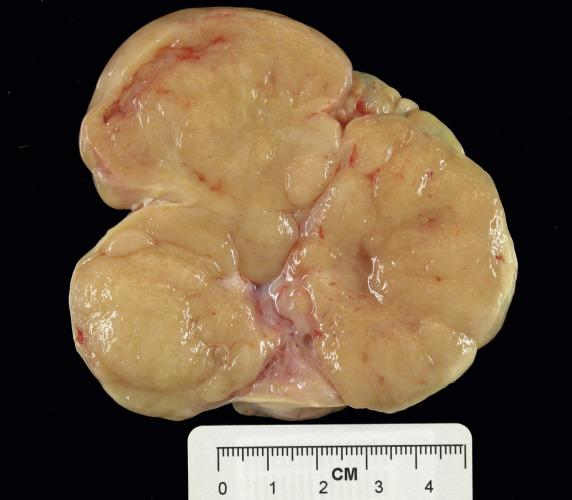
At scanning magnification, the tumor cells grow in nodules, sheets, trabeculae, and cords separated by fibrous septa ( Figs. 16.2 and 16.3 ). On occasion, poorly formed tubular and glandular structures may be apparent. The septal connective tissue is usually indistinct but may contain prominent lymphocytic aggregates, sometimes forming lymphoid follicles as well as plasma cells, eosinophils, and histiocytes forming epithelioid granulomas ( Fig. 16.4 ). Inflammatory cells (mostly lymphocytes) can also be seen within tumor nests, trabeculae, and cords and may be numerous enough to obscure the neoplastic cell population. The tumor cells are polygonal to round with visible cell borders and contain abundant eosinophilic cytoplasm. The nuclei are typically central or slightly eccentric with a round to “boxy” outline (“squared-off” appearance), coarse chromatin, and visible nucleoli, often more than one per nucleus ( Fig. 16.5 ). Mitotic activity is brisk and easily identifiable in most. A minor syncytiotrophoblast cell component is observed in 2%–3% of tumors, often around vessels or areas of hemorrhage ( Fig. 16.6 ). Other rare findings include luteinized stromal cells and microcalcifications (which, when present, may suggest an underlying gonadoblastoma).
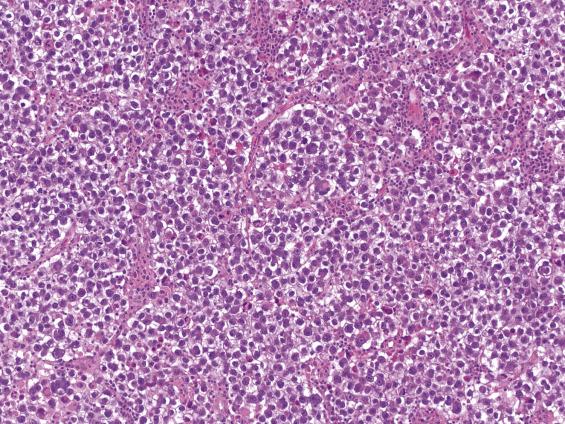
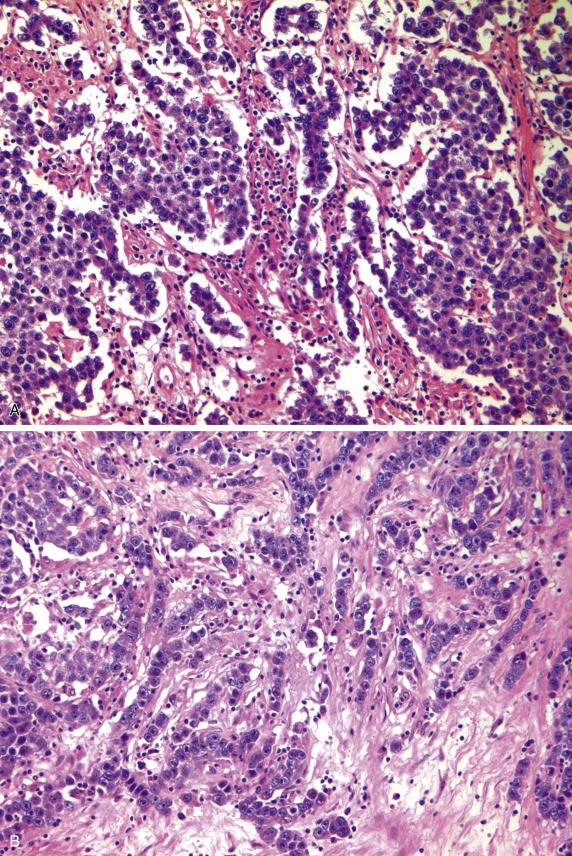
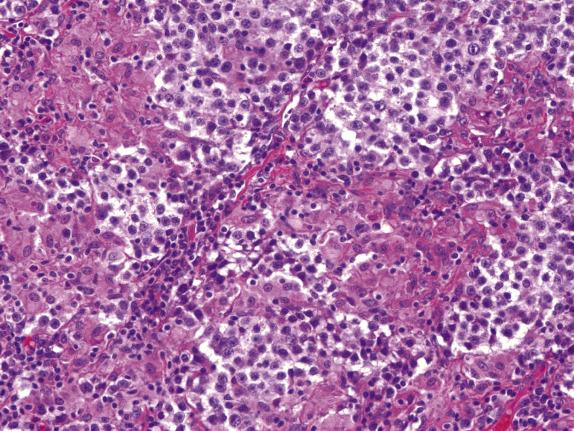
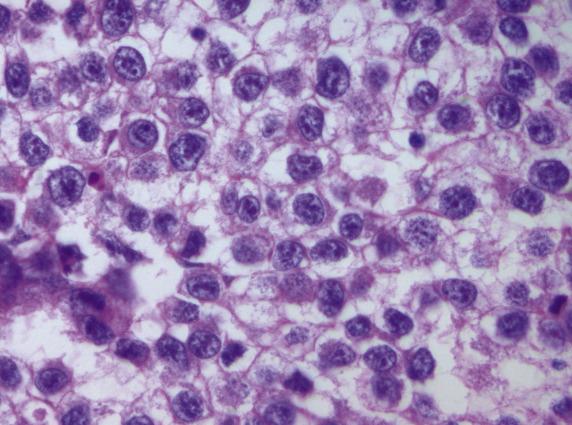
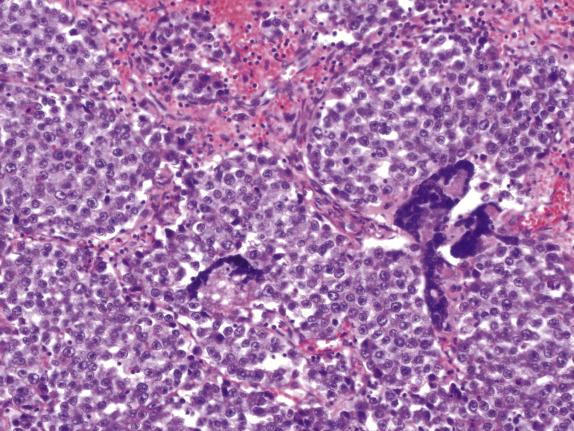
Fine-needle aspiration sampling, sometimes performed preoperatively, will yield a specimen with high cellularity, composed of loosely cohesive uniform round to polygonal cells with oval vesicular nuclei, granular chromatin, and large nucleoli. An admixture of lymphocytes, plasma cells, eosinophils, and (rarely) multinucleated epithelioid histiocytes is also characteristic. Moreover, the smeared glycogen-rich cytoplasm of the cells imparts a meshwork-like background, described as “tigroid” in Diff-Quik preparations.
Periodic acid–Schiff (PAS) stain highlights the abundant glycogen in the tumor cells; the staining will disappear after diastase treatment. By immunohistochemistry, dysgerminoma cells are positive for PLAP (strong, cytoplasmic staining), SALL4, CD117, and OCT4 ( Fig. 16.7 ). Other (less specific) positive markers include vimentin, LDH, neuron-specific enolase (NSE), and D2-40. Keratin expression, usually patchy, is seen in ∼30% of tumors. Dysgerminoma cells are negative for CD30, epithelial membrane antigen (EMA), carcinoembryonic antigen (CEA), S-100 protein, CD45, glypican-3, and AFP. Staining for β-hCG is confined to syncytiotrophoblast, if present.
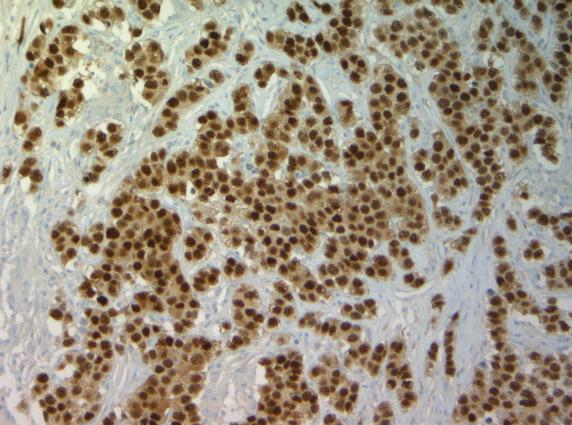
Like their counterparts in the testis, dysgerminomas are associated with chromosome 12 abnormalities, particularly isochromosome of the short arm i(12p). KIT mutations occur in 25%–50% of tumors, most commonly involving codon 816 of exon 17, which does not confer susceptibility to imatinib therapy. KIT mutations do not necessarily correlate with KIT protein expression and immunohistochemistry profile. KIT amplification is seen in about one-third of cases.
Dysgerminoma must be distinguished from other malignant germ cell tumors that may present with solid or nested growth. Yolk sac tumor will show a variation of architectural patterns, more primitive-appearing nuclei, presence of hyaline bodies, and absence of septa or prominent lymphocytic infiltrates. These tumors also typically show diffuse and strong immunoreactivity for cytokeratin and AFP and, in contrast to dysgerminoma, are positive for glypican-3 and negative for OCT4. CD117 is not helpful in this differential, as ∼50% of yolk sac tumors with solid pattern express CD117 to a variable degree. Embryonal carcinoma is extremely rare in the ovary and features a more primitive population with higher degrees of pleomorphism and hyperchromasia than dysgerminoma. In addition, embryonal carcinoma has glandular and papillary architecture, at least focally. Embryonal carcinoma is strongly and diffusely positive for cytokeratin and CD30 and in most cases is negative for CD117. OCT4 is not helpful in this differential diagnosis as both tumors are strongly and diffusely positive. Large cell lymphoma may mimic dysgerminoma grossly and microscopically; however, lymphoma is more often bilateral and involves other organs. Lymphoma typically grows in sheets, lacks septa, exhibits less uniform cytomorphology, and shows immunoreactivity for lymphoid markers. Clear cell carcinoma with a predominantly diffuse pattern may overlap with dysgerminoma; however, this tumor is typical of peri- or postmenopausal women and very rarely affects adolescents and young adults. A background of endometriosis and the more classic tubulocystic and papillary architecture are helpful clues for this diagnosis. Cytokeratin and EMA are weakly positive and negative, respectively, in dysgerminoma, whereas they are both strongly and diffusely positive in clear cell carcinoma. Clear cell carcinomas are, unlike dysgerminomas, positive for PAX8 and typically negative for SALL4 (although focal staining has been reported). Dysgerminomas with poorly formed pseudoglandular spaces or tubules may raise concern for Sertoli cell tumor . However, in the latter, the characteristic nuclear features of dysgerminoma are lacking, and inhibin, calretinin, and SF1 are positive, whereas OCT4 and PLAP are negative. Small cell carcinoma of the ovary, hypercalcemic type (SCCOHT) may be confused with dysgerminoma; however, in most cases of SCCOHT, there are focal follicle-like spaces containing eosinophilic fluid. These tumors show loss of nuclear expression for SMARCA4 (BRG1) and are also negative for OCT4, PLAP, and SALL4 and may be positive for EMA. Metastatic melanoma features large round nuclei with prominent nucleoli and thus shows morphologic overlap with dysgerminoma. A previous history of melanoma and the presence of intratumoral pigment are helpful clues. Immunohistochemistry for melanocytic markers, such as SOX10, HMB45, or Melan-A, should be considered and usually suffices to confirm this diagnosis. Undifferentiated carcinoma can be negative or only focally positive for epithelial markers; however, it is also negative for OCT4, SALL4, and PLAP and occurs in older (postmenopausal) patients.
The overall 5-year survival of dysgerminoma is 75%–90% and is highly dependent on stage, being 90% for patients with stage IA (∼67% of all cases) compared to 63% in patients with extraovarian disease. Most tumor recurrences occur during the first year. Metastases usually occur in the peritoneum, bone, liver, and lung, as well as pelvic, para-aortic, and retroperitoneal lymph nodes. Primary treatment includes unilateral salpingo-oophorectomy and biopsy of contralateral ovary as a fertility-sparing option or standard bilateral salpingo-oophorectomy and hysterectomy, followed by multiagent chemotherapy, most commonly BEP (bleomycin, etoposide, and cisplatin). Monitoring for tumor recurrence includes imaging and serum markers (LDH, PLAP, and β-hCG).
Malignant germ cell tumor resembling primordial germ cells
Ovarian counterpart of testicular seminoma and extragonadal germinoma
Most common primitive ovarian germ cell tumor (∼50%)
1% of all ovarian malignancies
Association with gonadal dysgenesis
Median age 22 years
Diagnosis during pregnancy common
Rapidly enlarging mass causing pain or pressure
Hormonal imbalances or paraneoplastic hypercalcemia
Elevated serum levels of LDH and PLAP
β-hCG elevated in 2%–3%
Normal serum AFP
75%–90% 5-year overall survival (better for stage I tumors)
Conservative fertility-sparing surgery (unilateral salpingo-oophorectomy)
Complete surgical resection and multiagent chemotherapy (bleomycin, etoposide, and cisplatin) for advanced disease or patients in whom fertility not desired
Serum levels of LDH and PLAP to monitor recurrences
In the ovary, this tumor type is exceedingly rare, comprising only 3% of all primitive germ cell tumors, and is morphologically identical to embryonal carcinoma of the testis.
It affects young girls and adults, with a median age at presentation of 12 years (range 4–28 years); ∼50% of patients are premenarchal. The typical presentation is
Large tumor (median 15 cm)
Solid, vaguely lobulated tan cut surface
~20% bilateral (macroscopic 10%–15%, microscopic 5%–10%)
Cellular tumor; solid, nodular, and trabecular architecture
Rarely, poorly formed tubules and glands
Uniform large polygonal cells with central round or boxy nuclei
Distinct cytoplasmic borders and clear to eosinophilic granular cytoplasm
Brisk mitotic activity
Inflammatory cells (mostly lymphocytes) admixed with tumor cells and in fibrous septa
Calcifications if associated gonadoblastoma
Highly cellular specimen with noncohesive large polygonal cells admixed with lymphocytes
“Tigroid” background due to smeared PAS-positive material
Abundant intracytoplasmic glycogen (PAS positive)
PLAP, SALL4, OCT4 and C-KIT positive
Patchy cytokeratin staining in up to 30%
CD30, EMA, CEA, S100, CD45, AFP and glypican-3 negative
Isochromosome 12p
KIT mutations are seen in 25%–50% of tumors, most commonly in exon 17, which does not confer susceptibility to imatinib therapy
Yolk sac tumor
Embryonal carcinoma
Large cell lymphoma
Clear cell carcinoma
Sertoli cell tumor
Small cell carcinoma of the ovary, hypercalcemic type
of a rapidly enlarging abdomino-pelvic mass causing pain or pressure. Other symptoms include isosexual precocity, irregular vaginal bleeding and menstrual cycles, amenorrhea, or virilization. Abnormal β-hCG levels are more frequent in this tumor type than in dysgerminoma (∼50% of cases). AFP levels are normal or only mildly elevated. An association with gonadoblastoma has been observed.
The tumor is unilateral and large (median size 17 cm). It shows a smooth outer surface and a solid, soft to friable cut surface with frequent hemorrhage and necrosis.
In its classic appearance, embryonal carcinoma features a highly pleomorphic cell population growing in solid sheets and poorly formed aggregates ( Fig. 16.8 ). Gland-like spaces and papillae are often admixed with solid areas ( Fig. 16.9 ). The tumor cells are highly atypical, which is noticeable at low power magnification. Their nuclei are irregularly contoured, have vesicular to coarse chromatin and display prominent nucleoli. The cytoplasm is variable in amount, vaguely granular and eosinophilic with indistinct cell borders ( Fig. 16.10 ). Mitotic activity is readily identified and includes frequent aberrant mitoses. Necrosis is common, either as focal confluent foci or as single cell necrosis. The presence of syncytiotrophoblast cells correlates with elevated β-hCG and hormonal manifestations; they are usually located at the periphery of the tumor or within hemorrhagic areas ( Fig. 16.11 ).
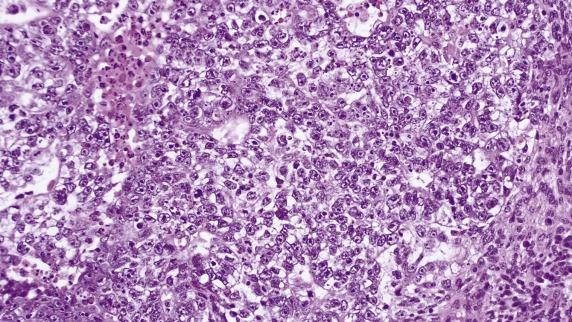
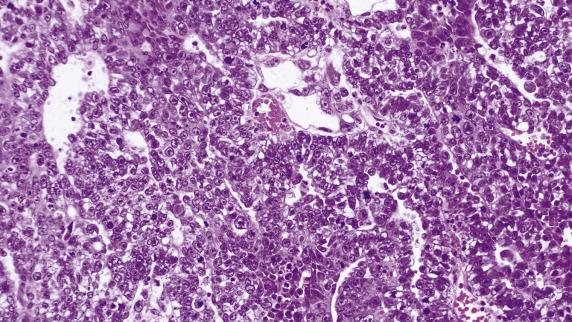
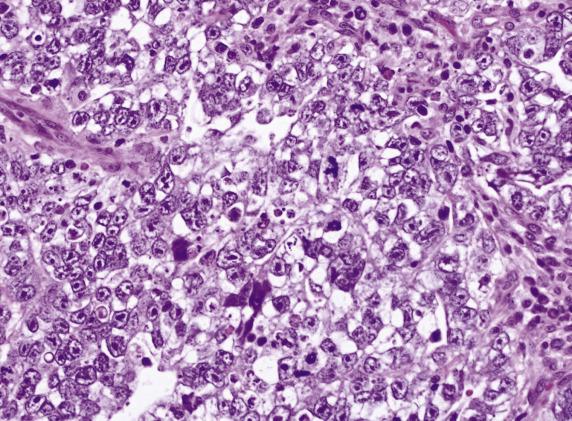
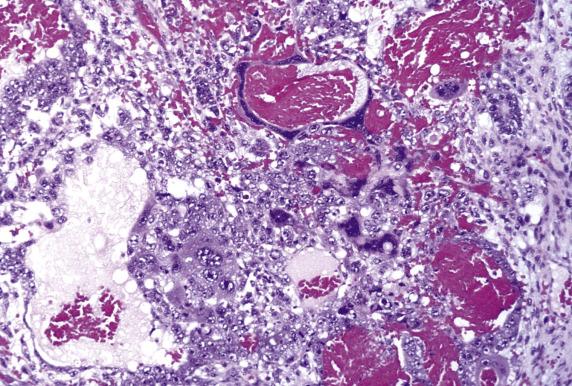
Embryonal carcinoma is strongly and diffusely positive for cytokeratin, PLAP, CD30 ( Fig. 16.12 ), SALL4, and OCT4. NSE may be positive, whereas C-KIT, EMA, CEA, glypican-3, and vimentin are usually negative. SOX2 is positive in ∼50% of the ovarian embryonal carcinomas and appears to be a less reliable marker compared to testicular embryonal carcinomas, most of which are positive for this marker. Positive immunoreactivity for AFP can be found in up to one-third of cases. β-hCG staining is usually confined to syncytiotrophoblast cells.
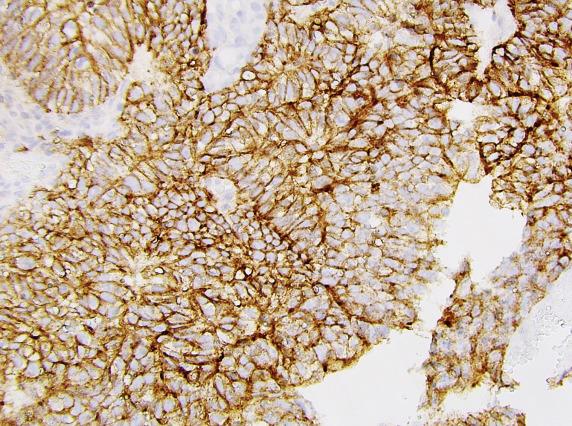
Most embryonal carcinomas contain an isochromosome or overrepresentation of 12p.
Embryonal carcinoma requires distinction mainly from other germ cell neoplasms. An embryonal carcinoma with a predominant solid pattern can mimic dysgerminoma ; however, the cells in embryonal carcinoma are more pleomorphic with a more overt primitive appearance and higher mitotic activity. In addition, dysgerminoma has fibrous septa and a prominent inflammatory component, and tumor cells tend to have distinct cell borders, which are not usually apparent in embryonal carcinoma. Diffuse and strong cytokeratin and CD30 staining are features of embryonal carcinoma, and a C-KIT-negative, CD30 and/or SOX2-positive result virtually excludes the possibility of dysgerminoma. Both tumors have a different prognosis and treatment; thus, their distinction is important. Yolk sac tumor usually displays less pleomorphism and more abundant cytoplasm and has a more developed architecture compared to the solid and pseudo-glandular appearance of embryonal carcinoma. In difficult cases, CD30 and OCT4 can be used as they are typically positive in embryonal carcinoma but negative in yolk sac tumor. In addition, AFP and glypican-3 are markers of yolk sac tumor and are negative in embryonal carcinoma. High-grade ovarian carcinoma , particularly high-grade serous carcinoma, undifferentiated carcinoma, and carcinosarcoma also enter in the differential diagnosis. All these entities typically occur in adult patients and are exceedingly rare in girls and adolescents. Unlike embryonal carcinoma, ovarian epithelial tumors are positive for EMA and negative for SALL4 and OCT4.
Embryonal carcinoma often presents with dissemination outside of the ovary into the peritoneum. Surgical management includes unilateral oophorectomy and debulking of any grossly visible tumor. If untreated, embryonal carcinomas are aggressive with a 5-year survival of ∼50%. Fortunately, these tumors are exquisitely sensitive to multiagent (BEP) chemotherapy, which achieves cure in most patients, even those with advanced stage at presentation. Serum β-hCG is used to monitor for tumor recurrence.
Germ cell tumor composed of highly primitive embryonic-type tissue
Rare (3% of primitive germ cell tumors)
Median age 12 years (range 4–28 years)
Rapidly enlarging mass
Hormonal imbalances
Often elevated β-hCG levels
Normal AFP
Extraovarian spread common
Surgical resection (can be conservative) and adjuvant chemotherapy (with high response rates)
Serum levels of β-hCG used to monitor recurrences
Nongestational choriocarcinoma, which is of germ cell derivation, is a rare very aggressive neoplasm accounting for <1% of primitive germ cell tumors. It can occur in pure form or as a component of a mixed germ cell tumor. Rare cases of a choriocarcinoma component arising from an ovarian epithelial tumor have been reported.
These tumors occur more frequently in children and adolescents (20 years or younger), but a small subset
Unilateral, large, and solid mass (median 17 cm)
Fleshy, friable cut surface with necrosis and hemorrhage
Solid or pseudo-glandular and papillary growth
Pleomorphic cells with large nuclei with vesicular chromatin and prominent nucleoli
Variable cytoplasm with indistinct cell borders
Brisk mitotic activity
Syncytiotrophoblast cells may be present
PLAP, SALL4, OCT4, CD30 and cytokeratin positive
SOX2, AFP, β-hCG and NSE sometimes positive
C-KIT, EMA, CEA, glypican-3 and vimentin negative
Isochromosome 12p
Dysgerminoma
Yolk sac tumor
High-grade ovarian carcinoma (serous, undifferentiated, carcinosarcoma)
occurs in patients of reproductive age. Patients present with an ovarian mass, which can rupture producing hemoperitoneum. Sometimes the tumor manifests with symptoms related to spread to distant sites (for instance, seizures or severe headaches caused by brain metastases). Isosexual precocity and hormonal menstrual imbalances are common, due to the abnormal β-hCG production. On imaging, the tumor appears as a highly vascular solid and cystic mass with hemorrhage and necrosis.
Choriocarcinoma is, like other germ cell tumors of the ovary, typically unilateral, large, and solid, often with extensive hemorrhage and necrosis.
Nongestational choriocarcinomas are indistinguishable from gestational choriocarcinomas on histology. They are defined by the presence of syncytiotrophoblast cells intimately admixed with cytotrophoblast cells and, less often, intermediate trophoblast cells ( Fig. 16.13 ). By definition, chorionic villi are absent. Syncytiotrophoblast is composed of large multinucleated cells with abundant eosinophilic, sometimes vacuolated cytoplasm and hyperchromatic smudgy nuclei. As these cells are terminally differentiated, mitotic figures are absent. Cytotrophoblast is comprised of smaller, medium-sized polygonal mononuclear cells with abundant clear to eosinophilic cytoplasm and monomorphic, centrally located nuclei containing conspicuous nucleoli and vesicular chromatin. Mitoses are frequent and often include atypical forms. Intermediate trophoblast cells are also mononuclear, round to polygonal, and relatively uniform but tend to be surrounded by fibrinoid material and cluster around dilated vessels, often showing vascular invasion. The syncytiotrophoblast component is usually the most prominent; however, in rare cases, sheets of cytotrophoblast or intermediate trophoblast comprise most of the tumor. Extensive hemorrhage and necrosis may obscure the tumor cell morphology.
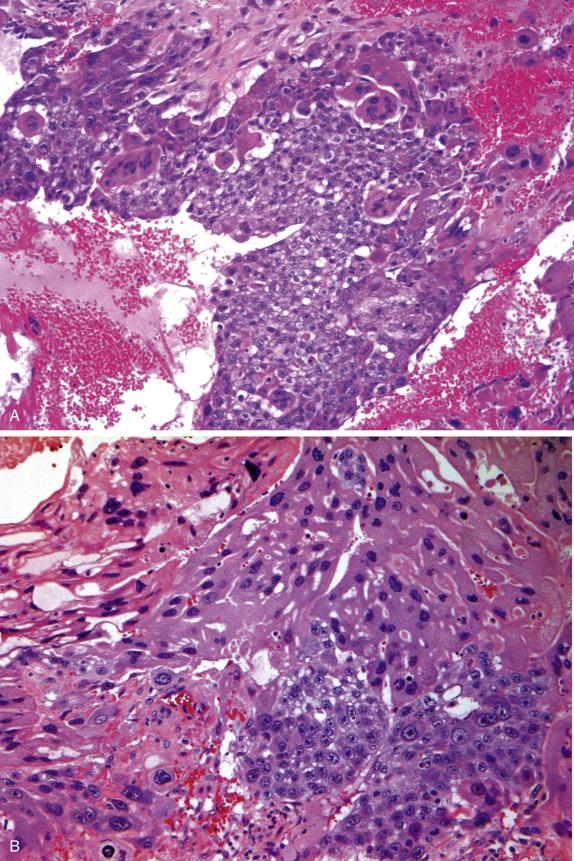
As nongestational ovarian choriocarcinoma is highly unusual, most of the evidence on immunohistochemistry of this tumor type comes from gestational choriocarcinoma and testicular germ cell tumors. All cellular elements of choriocarcinoma are strongly positive for pan-cytokeratin and low-molecular weight keratin, GATA3 (stronger in mononuclear trophoblast), glypican-3, and CD10. Other markers with less frequent positivity include SALL4 (∼70%), PLAP (50%), and EMA (50%). Syncytiotrophoblast is, in addition, diffusely positive for β-hCG and inhibin and variably positive for human placental lactogen (HPL). Intermediate trophoblast is positive for p63, inhibin, Mel-CAM, and HPL. Cytotrophoblast is positive for p63 but negative for inhibin.
Nongestational choriocarcinoma needs to be distinguished from a gestational choriocarcinoma originating from the uterus and secondarily involving the ovary. A similar scenario is gestational choriocarcinoma arising in an ectopic gestation (tubal or ovarian). This separation is mostly clinical, relies on the patient’s reproductive history, and cannot be made on pathologic examination alone. In a woman of reproductive age, the diagnosis of nongestational choriocarcinoma is, in essence, a diagnosis of exclusion and can be made only if there is no history of previous gestational trophoblastic disease or ectopic pregnancy. Genotype analysis can be contemplated, as it can determine the origin of the DNA content (paternal or maternal) and therefore determine the type of tumor (i.e., nonmaternal DNA content will be in keeping with a gestational choriocarcinoma). Importantly, syncytiotrophoblast cells can be observed in a variety of ovarian malignancies, including dysgerminoma, embryonal carcinoma, yolk sac tumor, and primary ovarian carcinoma. Adequate sampling is required to ensure that any of the previous morphologic types are represented, establishing the correct diagnosis.
Choriocarcinoma is an aggressive neoplasm, showing rapid progression and early metastases to distant sites including brain and lung. Treatment includes surgical resection (unilateral oophorectomy as a fertility-sparing option), followed by chemotherapy. Compared to gestational choriocarcinoma, which is highly sensitive to chemotherapy, nongestational choriocarcinoma has lower response rates. Stage is the most important prognostic factor. β-hCG levels are used to evaluate treatment response and detect recurrences.
Germ cell tumor with trophoblastic differentiation
Become a Clinical Tree membership for Full access and enjoy Unlimited articles
If you are a member. Log in here